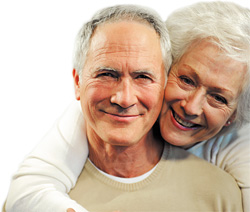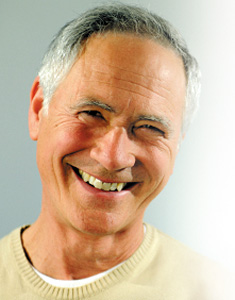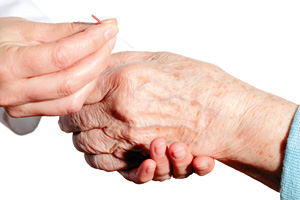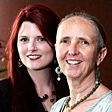Old age, believe me, is a good and pleasant thing. It is true you are gently shouldered off the stage, but then you are given such a comfortable front stall as spectator. - Confucius
Evidenced-based research shows acupuncture can be a clinically effective and cost efficient approach for many age-related health problems.5 Acupuncture is shown to protect the immune system against the negative effects of stress and aging by inhibiting inflammatory cytokines, 4 modulating leukocytes,9 increasing T-cells,3 and increasing IL-2 while decreasing IL-6.10
 Acupuncture treats aging-related pain through an analgesic and antidepressant effect resulting from increasing endorphin, encephalin, serotonin and dopamine levels in the brain.3 Although many of these studies relied on animal models, results are not influenced by placebo effects or the relationship between practitioner and client.
Acupuncture treats aging-related pain through an analgesic and antidepressant effect resulting from increasing endorphin, encephalin, serotonin and dopamine levels in the brain.3 Although many of these studies relied on animal models, results are not influenced by placebo effects or the relationship between practitioner and client.
Relevant clinical trials have examined the effects of both acupuncture and acupressure in older adults. A 2006 study randomized 38 acute hip fracture patients into acupressure versus sham group in the ambulance on route to the hospital. Statistically significant reductions in pain, anxiety, and heart rate were reported for the acupressure group.1
A 1999 Canadian study randomized 73 older adults with osteoarthritis of the knee into acupuncture and control group. Acupuncture was provided bi-weekly for eight weeks (GB34, SP9, ST36, 35, Xiyan, BL60, GB39, SP6, KD3; 34- gauge, EA 2.5-4 hz for 20 minutes). Significant reduction in the osteoarthritis index was seen in the acupuncture group including pain reduction of 34 percent by week four and 44 percent by week eight.2
Secondary benefits of pain studies have observed fewer side effects of medications for the group receiving acupuncture treatment, with 19 percent reducing their pain medications compared to only 13 percent of those in the conventional treatment group.8 Pain medication can contribute to a heightened risk of falling in older adults leading to potential life-threatening hip fractures; therefore, this benefit may have further important implications.
 How to Build It- So They Will Come
How to Build It- So They Will Come
The key as acupuncturists wanting to work with older adults is ensuring that our offices and services are accessible to this population. Some questions to ask: is the office easy to get to? is it handicapped accessible? can your treatments rooms accommodate a walker or a wheelchair? If all of these are not true, could you provide home, assisted living or nursing home visits to accommodate elder patients? are the sizes of the font on your marketing materials and intake form large enough to read for people with diminished vision? is there some message on your materials that speaks directly to this population- will they see themselves represented through a visual of an older person on your brochure or through conditions specific to aging listed?
If this is a population you have great interest in serving, consider creating a specific brand within your practice with separate business cards, brochure and tag line. Perhaps you showcase "Golden Agers Acupuncture" or "Seniors are our Specialty." Be politically sensitive and appropriate – for example, it is not considered appropriate to refer to older adults as the "elderly" as it's considered to be an adjective that is offensive to many. Set up presentations at senior centers and assisted living residences. Activity directors are always looking for speakers and if you include skill-building in your workshop by including an acupressure lesson or qi gong meditation all the better! Community style treatment can work well in these facilities because it provides a social activity at a lower price point. This population is eager to learn new skills and bring wellness to their lives, so providing health education is an excellent way to make a connection with potential new clients, their families, and their caregivers.
A recent experience illustrates the importance of timing and connecting with seniors. Twenty years ago, a senior day program started a twice-weekly acupuncture clinic for their clients. The day program offered several hours per day of programming for individuals over 60 years of age – social interaction through games and other activities, a lunch program, arts and crafts, exercise classes, and access to health and mental health resources. Although some of the staff, especially the social workers who had promoted the acupuncture programming were enthusiastic about the treatments, only a few seniors ever took advantage of the free service. After about six months, the program ended due to insufficient utilization.
 In May 2011, I attended a health and wellness fair that the same senior day center sponsored and provided free sample acupuncture treatments community-style. In 4-5 hours, treatment was provided to as many people as were treated 20 years ago in six months! Because timing truly is everything, acupuncture now enjoys greater acceptance in our community. The response was overwhelming – we built it and the seniors came!
In May 2011, I attended a health and wellness fair that the same senior day center sponsored and provided free sample acupuncture treatments community-style. In 4-5 hours, treatment was provided to as many people as were treated 20 years ago in six months! Because timing truly is everything, acupuncture now enjoys greater acceptance in our community. The response was overwhelming – we built it and the seniors came!
Older adults, like everyone else, respond to the very aspects that make our medicine so unique – treatments connect with clients through moving the qi that results in pain reduction and promotes a feeling of well-being. Enhancing wellness allows older adults to appreciate more of their "golden years" and to feel empowered about their health care.
As acupuncturists, we can experience the honor and privilege of working with this group, and appreciate inter-generational connections. We are reminded that we are part of the "creation cycle" in various parts of our lives as grandchildren and as grandparents, serving as important links in this ongoing rhapsody of life.
References:
- Barker, R., Kober, A., Hoerauf, K., Latzke, D., Adel, S., Kain, Z., & Wang, S. (2006). Out of hospital auricular acupressure in elder patients with hip fracture: A randomized Double-Blinded trial. Academic Emergency Medicine, 13(1), 19-23.
- Berman, B., Singh, B., Lao, L., Langenberg, P., Li, H., Hadhazy, V.,Hochberg, M. (1999). A randomized trial of acupuncture as an adjunctive therapy in osteoarthritis of the knee. Rheumatology, 38(4), 346.
- Cabýoglu, M. T., Ergene, N., & Tan, U. (2006). The mechanism of acupuncture and clinical applications. International Journal of Neuroscience, 116(2), 115-125.
- Kavoussi, B., & Ross, B. E. (2007). The neuroimmune basis of anti-inflammatory acupuncture. Integrative Cancer Therapies, 6(3), 251.
- Lafferty, W. E., Tyree, P. T., Bellas, A. S., Watts, C. A., Lind, B. K., Sherman, K. J., Grembowski, D. E. (2006). Insurance coverage and subsequent utilization of complementary and alternative medical (CAM) providers. The American Journal of Managed Care, 12(7), 397.
- Li, L., & Su, D. (2011). Trends in the use of complementary and alternative medicine in the united states: 2002–2007. Journal of Health Care for the Poor and Underserved, 22(1), 296-310.
- Lind, B. K., Lafferty, W. E., Tyree, P. T., & Diehr, P. K. (2010). Comparison of health care expenditures among insured users and nonusers of complementary and alternative medicine in Washington state: A cost minimization analysis. The Journal of Alternative and Complementary Medicine, 16(4), 411-417.
- Meng, C., Wang, D., Ngeow, J., Lao, L., Peterson, M., & Paget, S. (2003). Acupuncture for chronic low back pain in older patients: A randomized, controlled trial. Rheumatology, 42(12), 1508.
- Mori, H., Nishijo, K., Kawamura, H., & Abo, T. (2002). Unique immunomodulation by electro-acupuncture in humans possibly via stimulation of the autonomic nervous system. Neuroscience Letters, 320(1-2), 21-24.
- Su, X., & Xiangli, L. (2008). Regulative effects of auricular acupuncture, moxibustion and chinese herbs on immunologic function in the D-galactose-induced aging mouse. Journal of Traditional Chinese Medicine, 28(2), 129-133.
- Weiner, D. K., Rudy, T. E., Glick, R. M., Boston, J. R., Lieber, S. J., Morrow, L. A., & Taylor, S. (2003). Efficacy of percutaneous electrical nerve stimulation for the treatment of chronic low back pain in older adults. Journal of the American Geriatrics Society, 51(5), 599-608.
- Yu, Y., Kasahara, T., Sato, T., Guo, S., Liu, Y., Asano, K., & Hisamìtsu, T. (1997). Enhancement of splenic interferon-, interleukin-2, and NK cytotoxicity by S36 acupoint acupuncture in F344 rats. The Japanese Journal of Physiology, 47(2), 173-178.
Click here for previous articles by Elizabeth Sommers, PhD, MPH, LAc.
Click here for more information about Kristen E. Porter, PhD, MS, MAc, LAc.




